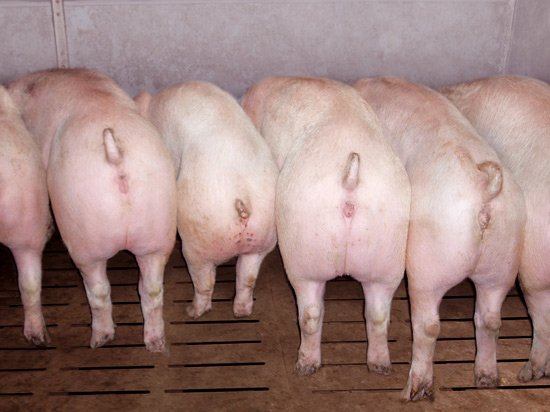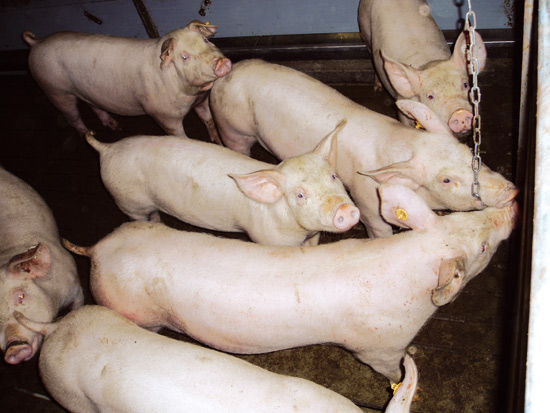4.3.7 How do we notice the reduced weight gain caused by Ileitis?
This is usually seen as variation among the pigs of the same age in the grower and finisher groups. While there are some pigs that appear to be growing well, at the target weight for their age, other pigs are below their target weight. If these pigs are well below their target weight, then they are easily identified as runted or stunted pigs. If however the reduction is not severe, then the true degree of reduced weights may only be seen by inspection and/or weighing of the animals. The pigs may have a normal or reduced feed intake, normal faeces, or some may have diarrhoea.
In some groups of pigs these mild changes are seen as a more mild, “sub-clinical” chronic form in the early growing period with low feed intake, sporadic diarrhoea, reduced average daily gain, poor feed conversion and increased within and between group weight variation.

Picture 4.3.7 a (by S. Lange)
Group of grower pigs affected by Ileitis: The pig in the middle is smaller – note these pigs have solid faeces.
Milder cases may be difficult to detect, but can be relatively common in the group. Therefore farms should be carefully inspected for apparent wasting of well-grown pigs, with irregular cases of diarrhoea and runt pigs. Records should be inspected to detect changes in average weight gains and feed conversion efficiency in the post-weaned groups. The reason why pigs can have intestinal lesions but no diarrhoea is that the actual changes or lesions may be confined to the ileum – causing reduced digestion and poor growth, but the lesions may not be widespread in the colon, so water levels in the faeces are normal (no diarrhoea).
In some of these subclinical infected pigs the more severe chronic form can develop, with long-standing excretion of the organism and chronic lesions leading to obvious runting of the pigs.

Picture 4.3.7 b (by S. Lange)
Increased variation in weights of pigs in the Grower-finisher groups.
© Boehringer Ingelheim Animal Health GmbH, 2006
All rights reserved. No part of this Technical Manual 3.0 may be reproduced or transmitted in any form or by any means, electronic or photocopy, without permission in writing from Boehringer Ingelheim Animal Health GmbH.




